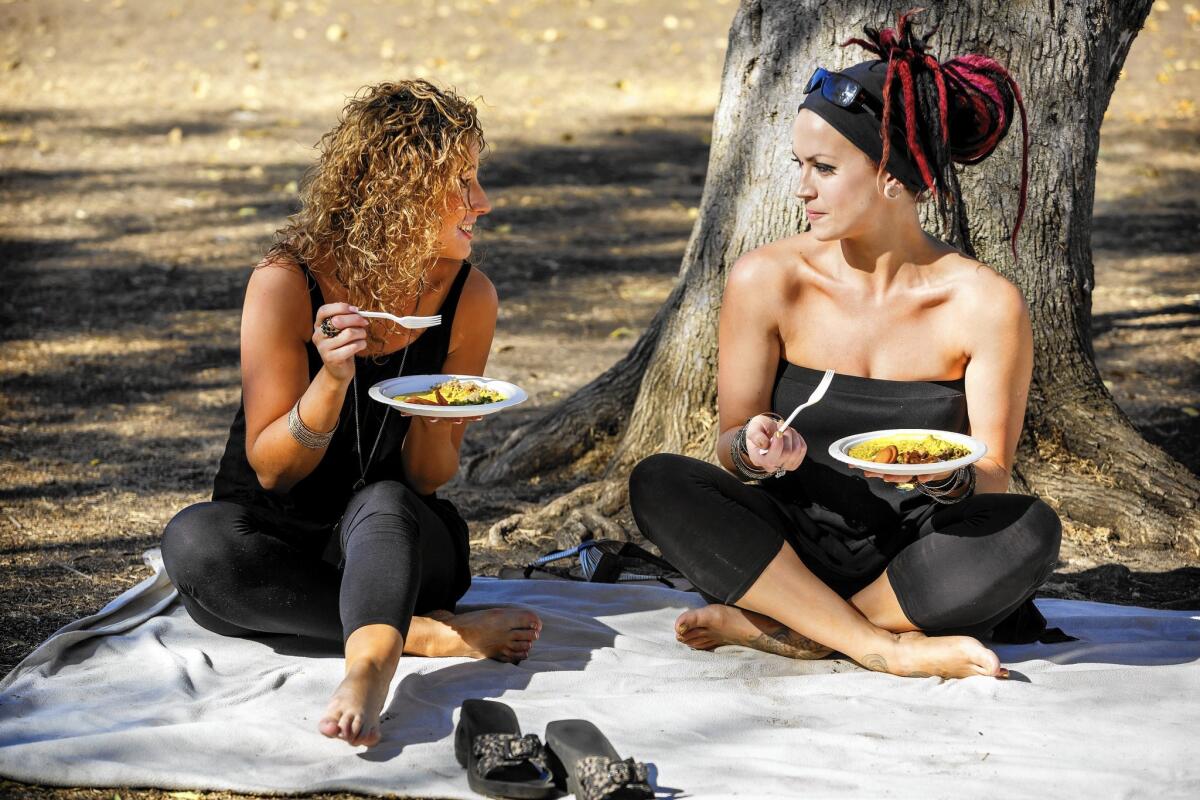3 dietary lifestyles up close: Paleo, veganism and Slow Food movement

I wasn’t sure what to bring to the dinner party. My hosts were not only gluten-free, they were also on the Paleolithic diet. Based on the premise that people are healthiest when they follow a diet that early humans evolved to eat, the “Paleo” diet consists of foods similar to what might have been available before agriculture — basically, plants and animals. That means no grains, no dairy and minimal processing, which ruled out most of the potluck side dishes I’d come to rely on.
My hostess reassured me that a simple green salad was fine, adding that I needn’t worry about dressing because she would make a Paleo-friendly one. So I showed up with a bowl brimming with raw veggies, kicked off my shoes and followed my barefoot friends to their backyard, where a fire pit blazed. We sat beside a planter box of giant ferns and ate bacon-wrapped dates, grilled padron peppers and deviled eggs, the last of which came from the chickens in the yard.
As we moved on to the main course — bunless hamburgers made from grass-fed beef and served on a bed of organic lettuce — my hosts talked about their favorite foods, including free-range bison, lamb lollipops and the broth they made by boiling chicken feet and bones for 36 hours “so you get the nutrients from the marrow.” But they also talked about the health benefits of going shoeless and how they use blackout shades so their bedroom approximates the sleeping environment of a dark cave.
“It’s definitely more of a lifestyle than a diet,” my host said, the firelight flickering behind him in a way that seemed too primal to be true. Suddenly, the old adage “you are what you eat” had taken on new meaning.
More and more, whether they are consuming slabs of meat for the Paleo diet or forgoing animal flesh out of compassion for sentient beings, people seem to embrace their food choices as part of a larger way of living. Here is a glimpse into three popular dietary lifestyles:
Paleo living
Drawing from the field of epigenetics, the study of how chemical reactions activate or deactivate certain genes in the body, Paleo enthusiasts try to “reprogram” their genetic expression through diet and behavior. Mark Sisson, author of “The Primal Blueprint,” explains: “We all possess a genetic recipe to build a strong, fit, healthy human. But in order to do that, our genes need certain inputs to turn them on or off.”
The inputs he refers to include those that might have increased the fitness of Paleolithic humans: a diet high in protein, fats and vegetation; a hunter-gatherer activity mode of frequent slow movement punctuated with bouts of heavy lifting and occasional sprints; at least 7½ hours of sleep after nightfall; and plenty of natural sunlight.
That’s why Sisson outfitted his Malibu office with desk treadmills for his employees and encourages everyone to “figure out ways to move your body throughout the day to engage as many muscle groups in as much range of motion as possible.” He also recommends that people limit the amount of artificial light they’re exposed to at night — especially “blue” light from screens — and that they set their bedroom thermostats to a cave-like 67 degrees.
Another tenet of Paleo living is nurturing the microbiome in your gut, says Tim Roach, co-founder of PaleoFoodBars.com, which features food bars for primal eaters on the go. Roach regularly consumes raw, fermented foods such as homemade sauerkraut and kombucha for their probiotic properties, touting benefits that include improved digestion, immune response and mood.
“Is the Paleolithic style about trying to go back and re-create the lifestyle of a caveman? Absolutely not,” says Sisson. “It’s about taking clues from evolution then figuring out how to [implement them in a way that is] simple and painless in this modern, and sometimes hedonistic, existence.”
Veganism
If you went to Rancho Park on L.A.’s westside on Thanksgiving, you likely encountered a gathering of kindred souls claiming their own holiday traditions. Instead of eating birds, they celebrate birds.
“Everyone brings a vegan dish to share — no flesh, no dairy, no honey,” says Dave Rubin, an organizer of the annual Rancho Park Vegan Thanksgiving Potluck. The animal-free feast has been held for 20 years, attracting nearly 300 people in 2014.
“We connect to the spiritual component of being vegan. ... It’s a commitment to live without doing harm,” says Rubin, who also organizes roaming “no-meat and mingle” potlucks throughout L.A. County as well as “VeggieDate,” a vegetarian dating site at https://www.veggiedate.org.
Lisa Levinson, organizer of the Vegan Spirituality Meetup group in Los Angeles (www.meetup.com/Vegan-Spirituality), emphasizes the importance of being part of a community. “In L.A., it’s like a big tribe of vegans. There’s a feeling of solidarity.”
Past Meetup activities include animal-themed film festivals, art exhibitions and book discussions, a talk from a visiting Tibetan monk, and walks through animal sanctuaries.
“What you eat is only part of it,” says Levinson. “It has to do with your whole spiritual awareness [and] broadening your human compassion to include nonhuman animals.”
The Slow Food movement
Parked on a coastal terrace between Santa Cruz and Half Moon Bay, a restored 1954 Airstream trailer rests amid the oldest organic strawberry farm in California. Out front, a hand-painted sign reads “Slowcoast.” Inside and around the trailer are products on display: teas and salves, honey and wine, soaps, goat cheese, up-cycled farm shirts and jewelry fashioned from found sea glass.
“Everything we sell is either from this 50-mile stretch of coastline or somehow thematically tied in,” says Dana Nichols, co-founder of Slowcoast (www.slowcoast.org). Nichols and her husband decided to open up shop after walking the entire California coast, from Oregon to Mexico.
Slowcoast embodies what the Slow Food movement is all about: good, clean, fair food. In other words, high-quality, regional foods produced using environmentally friendly and fair-labor practices. This seems simple on a sparsely populated coast that’s adjacent to farmland. But is it possible to live the Slow Food life in L.A.?
Absolutely, says Ernest Miller, co-chair of Slow Food Los Angeles (slowfoodla.com). “Although you think of L.A. as an urban environment, there is still agriculture surrounding us…. Because of our climate, our farmers markets operate year-round at incredible levels of productivity.”
Alexandra Agajanian, also co-chair of Slow Food Los Angeles, adds that the mild weather makes backyard gardening easy — and the Master Food Preserver Program offered through UC Cooperative Extension teaches Slow Foodies how to can their own foods.
Neither Miller nor Agajanian patronize fast-food restaurants, which are the antithesis of the movement, and they try to buy even non-food items from local businesses.
“It’s a lifestyle because it does actually cause you to slow down,” says Agajanian. “Making your own cheese, beer or wine — or supporting someone who does — creates a sense of patience.”
More to Read
Eat your way across L.A.
Get our weekly Tasting Notes newsletter for reviews, news and more.
You may occasionally receive promotional content from the Los Angeles Times.









